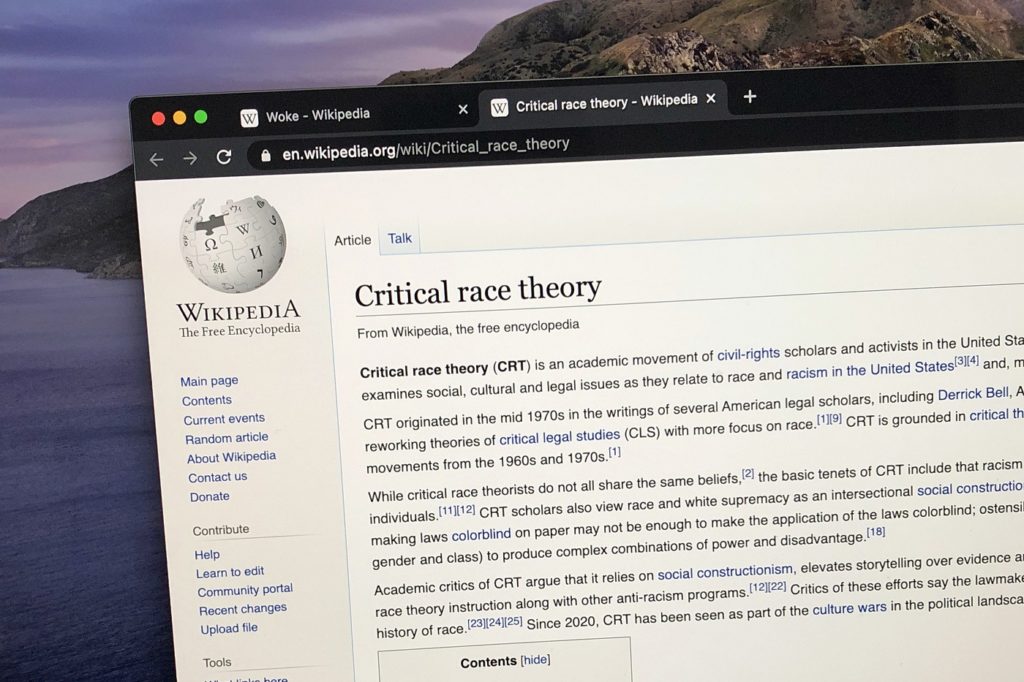Soon we will stop arguing about Critical Race Theory. Not because it is wrong and will be defeated, nor because it is right and will be victorious, but because it is provocative and will have served a purpose—perhaps a providential purpose: challenging a persistent secular myth.
Meritocracy and individualism, equality and freedom: these are elements in what was supposed to be a unifying story, America’s Noble Lie. When tested in the past, this story has been strengthened and revised. The integration of Catholic immigrants and the civil rights movement of the 1960s could gain widespread support in part by reinforcing, not discarding, key elements of our founding myth.
Critical Race Theory (“CRT”) has been divisive because it is framed, most commonly, as directly rejecting this myth—even symbolically, by rejecting the founding date of our nation. The controversy over the 1619 Project is not about historical details. Instead, it has everything to do with the audacity of proposing an alternative national story. CRT threatens to overturn, rather than develop, our inherited narrative of social unity.
This is the context for battles playing out in school boards and state legislatures over the teaching of CRT. Many lament politicians meddling in education, but arguing about how we will educate children is one of the signs of a healthy polity. Insofar as we take seriously the question of who we are and how we will live together, we must take seriously the education of children. This is especially true when it comes to the stories we tell them about their social identity.
Start your day with Public Discourse
Sign up and get our daily essays sent straight to your inbox.Should CRT be prohibited in schools? Should it be mandated? Only superficially and locally do these questions implicate the rights of teachers or academic freedom. Legislatures and school boards do and should regulate instruction in countless other matters. Policies about CRT in schools, which appear to compel or censor speech, in fact enact a conversation, too long deferred, about the future of America’s founding myth.
History is complicated, and no founding myth is flawless. The myth of meritocracy, individualism, freedom, and equality never fully captured everyone’s experience. The question, which is now being forced into the open, is whether our inherited myth can be corrected in a revised version, or whether it will have to be replaced with a new myth, perhaps one not yet articulated.
Policies about CRT in schools, which appear to compel or censor speech, in fact enact a conversation, too long deferred, about the future of America’s founding myth.
The classic American myth can absorb many of the insights of CRT. Human beings can be victims of systems and structures. People from different backgrounds can experience this in different ways. Certain ideas of race are modern inventions playing powerful roles in people’s lives. We may be blind to our own biases and prejudices, and attempts at “objectivity” and “fairness” themselves sometimes rationalize self-interest. Awareness of all this can be a difficult matter of justice.
All these are genuine reminders of the social complexity of human brokenness, which any healthy polity must acknowledge. At its best, CRT is an affirmation of the human condition, including sin, libido dominandi, suffering, and hope for redemption.
At the same time, CRT poses a harder challenge—precisely insofar as our traditional story has evolved to condemn racist discrimination and overt race-consciousness. While CRT rejects some conceptions of race, it seems to reify others. Apparently reducing human association to relations of power, CRT can even undermine the ideas of a common human nature, and of justice as spiritual harmony.
CRT’s attack on traditional social concepts can fail to distinguish Enlightenment rationalism from Christian humanism. And CRT notoriously causes linguistic confusion, redefining various terms (“whiteness,” “white supremacy,” “racism”) for use in technical truisms (“All and only white people are racist”), which may—or may not?—still draw on the moral stigma associated with conventional usage.
As a result, many people don’t experience CRT as an invitation to reconciliation and unity, or even as a call to self-examination, but as an ideological weapon designed to manipulate and divide. At its worst, CRT is received as a denial of the human condition, including sin, libido dominandi, suffering, and hope for redemption.
History is complicated, and no founding myth is flawless. The myth of meritocracy, individualism, freedom, and equality never fully captured everyone’s experience.
These aren’t contradictions. It is a strength and weakness of CRT that it is many things: a sociology of what is, and an ethics of what should be; a useful but limited analytic tool for academic study, and a master narrative offering meaning and purpose to a confused and alienated generation.
The fact is, “Critical Race Theory” is diffuse, a family of loosely related trends: a school of legal theory, a pedagogical practice, an HR training framework, a speech code, a culture war meme. No wonder engaging with CRT can feel like a frustrating shell game. To the exasperation of academics, the most prominent public voices on opposite sides of the CRT wars can seem to have an oddly symbiotic relationship, benefiting from confusion. Are they courageous civic advocates or cynical opportunistic grifters?
Notably, recent state regulations about CRT, pro and con, often avoid mentioning it by name, instead describing particular theses about the nature and history of human relationship. This is appropriate and encouraging. Now that CRT has blessed us with a challenge to our national myth, soon we will all stop arguing about “Critical Race Theory,” and turn our attention instead to the things it was supposed to be about: our past, our social nature, our woundedness, and sources for solidarity and hope.
This is the gift of CRT, and the blessing of current arguments about school curricula. A healthy political community will find ways to reflect on and revise its founding myth. Actions in legislatures and state education boards are proxy arguments over the future of our constituting narrative. For catalyzing this, we should be grateful to CRT—for its insight, for its limitations, and even for its clarity-inducing confusions.














